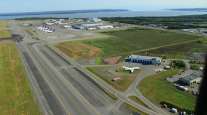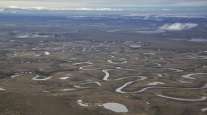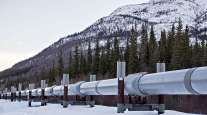Staff Reporter
Construction Costs Soar on Alaska Freight Route

[Stay on top of transportation news: Get TTNews in your inbox.]
Inflation is blamed for sending project completion costs soaring 68% since 2021 to today’s $840 million to complete a vital freight route for bringing goods into Alaska from the port in Anchorage.
Ryan Anderson, commissioner of the Alaska Department of Transportation and Public Facilities, issued an announcement July 21 that rising costs may jeopardize completion of a long-term construction project to improve a section of Sterling Highway with tight curves and no shoulders dating from its original construction in 1950.
At issue is the Cooper Landing Bypass (the first phase of the Sterling Highway new alignment that begins at milepost 46.5 and ends at MP 56).
That project is meant to reduce congestion in Cooper Landing, increase road safety, make vehicle traffic more efficient and provide better access for residents and businesses. The Sterling Highway is part of the National Highway System.
Citing project costs that have doubled over the past five years, Anderson said DOT&PF “is evaluating options to seek discretionary grant opportunities and innovative financing to keep the project on track without having to delay hundreds of other transportation projects statewide over the next three years.”

The project is ongoing, with the Highway Trust Fund expected to cover 90% of the cost and the state of Alaska the rest. (Alaska Department of Transportation & Public Facilities)
Construction, important during Alaska’s summer weather, continues on the project “as the state works to mitigate increasing project cost estimates.” The plan is to revitalize 15 miles of two-lane highway with new wildlife and pedestrian crossings, trailheads, a highway bridge over Juneau Creek, additional intersections and passing/climbing lanes.
“This is an important route for freight,” DOT&PF spokesperson Shannon McCarthy told Transport Topics. “The majority of goods coming into Alaska come in from the Port of Alaska in Anchorage, and this route is the main route to Kenai, Soldotna and Homer, and other smaller communities.”
DOT&PF said the overall design, utility and right-of-way acquisition has been developed to occur in six stages. Construction began in 2020 and was slated for completion by 2027. Money from the federal Highway Trust Fund was anticipated to cover 90% of total construction, while Alaska is to pay for the remaining 10%.
“Alaska DOT&PF has seen inflationary pressures on construction costs throughout the state over the past two years,” said John Binder III, deputy commissioner. “We will be making considerable effort to ensure we can keep the project on schedule despite these challenges.”
In 2018, project completion was estimated to cost $350 million. It has risen each year. The final price tag jumped to $499 million in 2021 and even further to $690 million the following year. This year, the state forecast project completion to reach $840 million.
“The cost estimate changes between 2022 and 2023 alone represent an 18% increase in pricing, outpacing previous estimates. As the state works to resolve the shortfall in the near term, the 2024-2027 Statewide Transportation Infrastructure Program and the FY25 Capital Budget will reflect project needs over the next four years,” according to the DOT&PF.
Building of bridge abutments is expected to start in 2024, with bridge construction continuing through 2026.
“Currently, as designed, the Juneau Creek Bridge will be the highest crossing in the state at 285 feet and the longest single-span bridge in Alaska,” noted Anderson’s announcement. The steel girder bridge spanning Juneau Creek will be designed with wildlife protection features: four wildlife under-crossing structures and the first wildlife overpass of a highway in Alaska.
The Sterling Highway was built from the 1940s to 1950s as a gravel road and not designed for today’s heavy traffic.
Want more news? Listen to today's daily briefing below or go here for more info:




